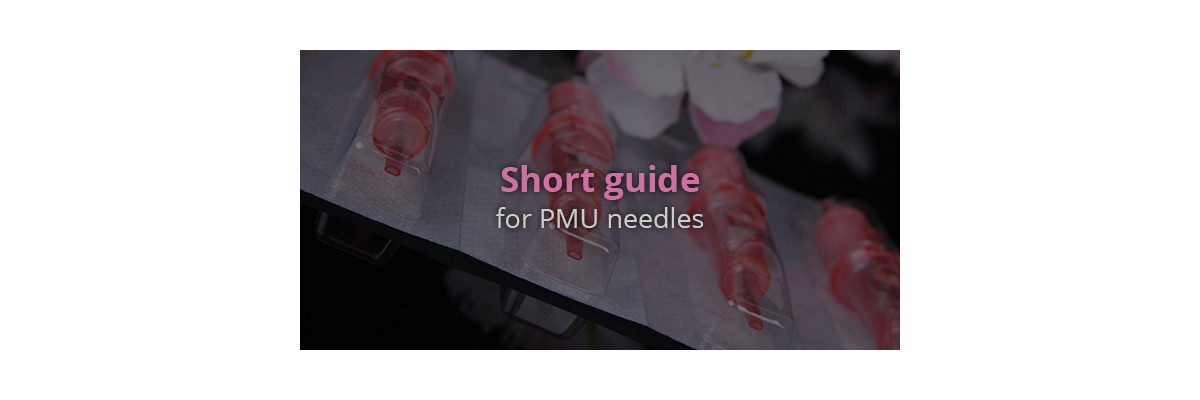
Meanwhile, there are a variety of PMU needles of different types and sizes on the market. It is not so easy to keep track of
them all. To help you decide which permanent makeup needles are right for you, we will explain below the differences
between the individual models and what you should look out for. Not all needles are the same.
First of all, when we talk about PMU needles, we usually mean the ready-soldered needles in the Microblade or in the needle
module.
What needle tip shapes are there?
In technical terminology, needle tips are called tapers. Depending on the application, one or the other PMU needles are more
or less suitable. If you are overwhelmed with the abbreviations MT, LT, PT, XTL and BP, I can reassure you. These are simply
the designation of the length and nature of the needle tip.
MT = Medium Taper (medium length tip)
Suitable for thicker contours and for filling color areas.
LT = Long Taper
Ideal for precise and fine lines
PT = Point Taper (blunt taper)
Slightly blunter than Long Taper, therefore gentler on the skin. Especially suitable for eyeliner and lip.
XTL = Extreme Long Taper (very long tip)
Mainly intended for contours
BP = Bug Pin (finest taper type)
Roughened surface transports more color into the skin. Especially suitable for line work.
Now that you have learned about the differences between needle tips, we can delve deeper into the subject into the matter.
What types of PMU needles are there and what are they used for?
Round Liner
Let's start with the most important permanent makeup needles, the Round Liner needles. As the name suggests they are
ideal for drawing lines. The needles are arranged in a circle and soldered. They run cone-shaped to each other at the tip,
making them perfect for contouring and eyeliner. Due to the arrangement and nature of the needles, only a small amount
of ink is absorbed and held for as long as possible. Depending on the number and strength of the needles, the thickness
of the lines varies. The fewer the needles and the thinner the tip, the finer and more filigree the lines.
Round Shader
These PMU needles are very similar to the liner needles, but there is one serious difference: the Round Shader needles have
a longer solder-free area. This means that the tips of the individual needles run straight and are further apart. This means
that a larger bare area is visible, which makes the needles more flexible and more resilient during piercing. Since the Round
Shader needles are so-called OneOffLiners, they are arranged as round as possible so that a cavity can form in the middle.
More ink is absorbed there, which ultimately has more room to flow. Round shader needles are mostly used for simple
shading and for filling color.
Flat Shader
Flat Shader needles are lined up next to each other on one level and are soldered in a straight line. The color pickup is slightly
less than roundshaders, but you can use them to tackle larger shadings. Shading produces a lighter result than Round Liner
needles because they only go through the skin once. With Lining, on the other hand, the needles are passed through the
epidermis one after the other, which results in extremely dark lines are created.
Magnum Shader
Let's move on to the most popular variant for shading, the magnum shaders. The needles of this type are spread and form
two rows at the tip. The individual needles are far apart and absorb a lot of ink. so that the ink can be worked into the skin
quite easily. The color pigments distribute The color pigments distribute optimally in the skin, making the Magnum Shader
needles ideal for filling large areas.
Curved Magnum Shader
Since these needles allow extremely soft transitions when shading, they are also called soft edge needles. The structure
of the needles is the same as for the Magnum Shaders, except that the needles are arranged in a curve. This does not
necessarily make the application easier for beginners, but for experienced PMU artists, the even distribution of the color
in the skin is a real advantage.
Which needle size is the right one for my purposes?
As already mentioned, the diameter of the needle also plays a decisive role in the search for the suitable permanent Make
Up needles.
The four most common strengths:
#8 = 0,25mm
Favors a slower color flow for especially detailed and precise work, but is also more more sensitive.
#10 = 0,30mm
Most popular thickness, as an even flow of pigment is possible for all applications.
#12 = 0,35mm
Optimal for coarser lines and suitable for filling areas.
#13 = 0,40mm
Mainly used for large-area PMU treatments.
What number of needles should I choose?
Another indication of what thickness the line will have in the end is the number of needles. Accordingly, the line will be
thicker with a higher number of needles. Usually, the number of PMU needles is placed after the number for the thickness
of the needle. Thus, a Round Line needle with a gauge of #8 and a number of 3 needles would have the designation 0803 RL.
Not so complicated, is it? :)
But if you are not sure which needles are best for you and your style, it is a good idea to do a few to make a few trial runs
beforehand. In our assortment you will find suitable practice skins made of silicone, as well as all common needle types.
